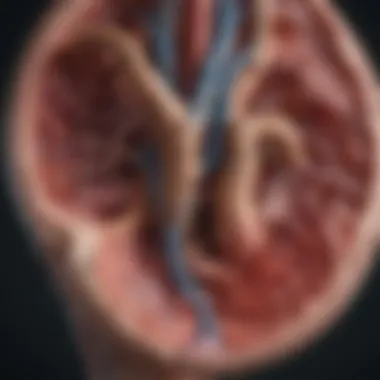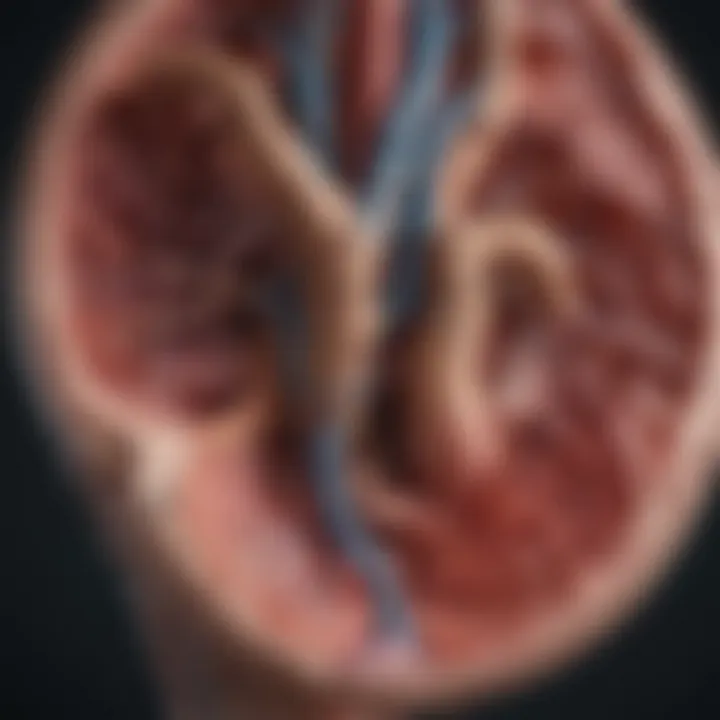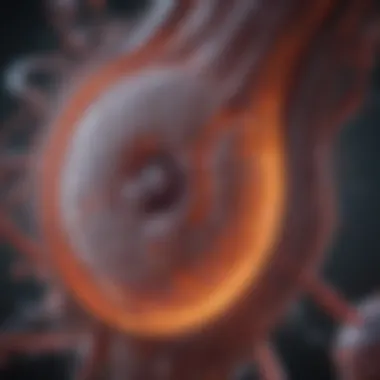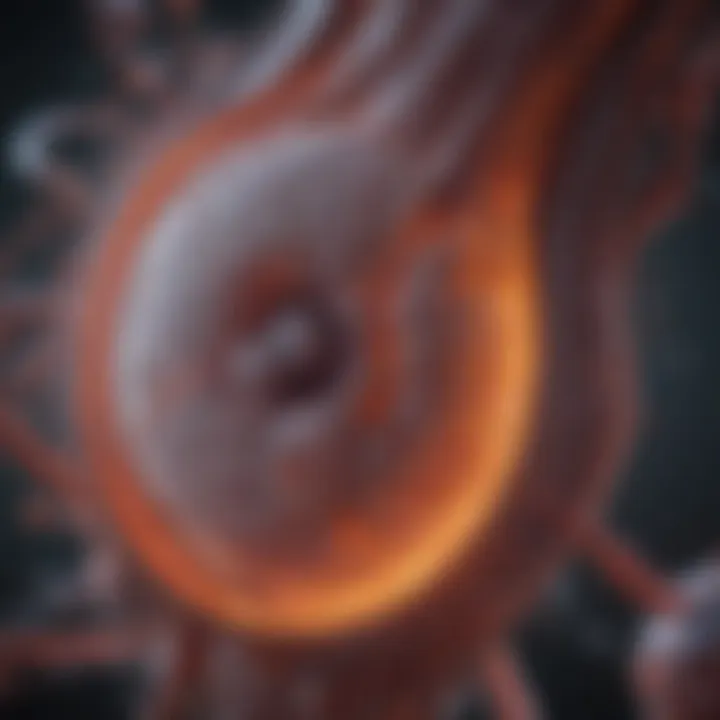Understanding Kidney Function: A Comprehensive Analysis


Intro
The kidneys are vital organs in the human body, performing essential functions that ensure homeostasis and overall health. Despite their importance, many individuals lack a comprehensive understanding of how these organs operate. This article aims to illuminate the complexities of kidney function, addressing key aspects such as anatomy, filtration processes, and common disorders.
Overview of Research Topic
Brief Background and Context
The kidneys are a pair of bean-shaped organs located in the lower back, playing a central role in regulating bodily fluids and expelling waste. They filter blood, reabsorb necessary substances, and secrete waste products. Known for their intricate structure, each kidney contains millions of nephrons, the functional units where filtration occurs.
Importance in Current Scientific Landscape
Research on kidney function is increasingly relevant in light of the rising incidence of kidney diseases. Conditions like chronic kidney disease and diabetes mellitus have gained attention for their associations with kidney dysfunction. Understanding renal physiology not only aids in diagnosis and treatment but also facilitates preventive strategies to maintain kidney health.
Methodology
Research Design and Approach
The analysis of kidney function draws upon a multifaceted research design that includes both experimental and observational studies. By synthesizing various research findings, this article aims to establish a well-rounded understanding of renal physiology.
Data Collection Techniques
Various data collection methods have been utilized, including clinical studies and laboratory analyses. Studies often involve assessing kidney function through metrics such as glomerular filtration rate (GFR) and blood urea nitrogen (BUN) levels. This combination of approaches helps present an informed perspective on the subject.
"The kidneys, while small in size relative to other organs, play a monumental role in the maintenance of internal balance and health."
Key Points to Discuss
- Anatomy of the kidney and nephron structure
- Mechanisms of filtration and absorption
- Factors influencing kidney health, including diet and hydration
- Common disorders and diseases of the kidney
- Preventive measures and treatment options
This article will explore these elements, aiming to provide clarity and insight into the essential functions of the kidneys, making the information accessible for students, educators, and professionals alike.
Prolusion to Kidney Function
The kidneys are vital organs that play an essential role in maintaining homeostasis within the body. Understanding kidney function is critical because they contribute to a variety of physiological processes that ensure the proper functioning of organ systems.
In this article, we will explore several key aspects of kidney function, including their structure, filtration mechanisms, and the various factors affecting their health. Recognizing the importance of kidneys not only informs our understanding of human health but also elucidates potential risks and complications associated with kidney disorders.
The kidneys filter blood, regulate blood pressure, and manage electrolyte and fluid balance. They also produce hormones that influence red blood cell production and calcium metabolism. This extensive role underscores the necessity of maintaining healthy kidney function, which is crucial for overall well-being.
Definition and Importance of Kidney Function
Kidney function refers to the processes by which the kidneys filter blood, remove waste products, and maintain the body's fluid and electrolyte balance. Each kidney contains approximately one million functional units called nephrons, which are essential for carrying out these tasks.
When kidney function is compromised, waste products can accumulate in the bloodstream, leading to serious health issues such as chronic kidney disease and acute kidney injury. Understanding how kidney function works can aid in early detection and management of such conditions.
Overview of Renal Physiology
Renal physiology encompasses the study of kidney function and the mechanisms involved in urine formation and regulation of bodily fluids. The kidneys perform several critical functions:
- Filtration: Blood entering the kidneys is filtered to remove waste products and excess substances. The key site for filtration is the glomerulus, a network of tiny blood vessels.
- Reabsorption: After filtration, essential substances like water, glucose, and electrolytes are reabsorbed back into the bloodstream through the renal tubules. This process is vital for maintaining homeostasis.
- Secretion: The kidneys also actively transport certain substances from the blood into the renal tubules, a process known as secretion. This helps eliminate drugs, metabolites, and excess ions.
In summary, kidney function is essential for sustaining life and supporting numerous physiological processes. A comprehensive analysis of renal physiology highlights the intricate balance that the kidneys maintain within the human body.
Anatomy of the Kidney
The anatomy of the kidney is essential to understanding its function within the body. Each kidney is a complex organ, consisting of both external and internal structures that work together to maintain vital processes such as filtration, absorption, and secretion. By exploring the anatomy, one gains insight into how various components contribute to kidney operation and health. This knowledge is crucial for students, researchers, and healthcare professionals engaged in nephrology and related fields.
External Structure
The external structure of the kidney provides immediate insights into its protective layers and overall shape. Each kidney is bean-shaped and about the size of a fist. Positioned on either side of the spine, they are encased in a layer of fat known as perirenal fat, which serves as insulation and cushioning. The renal capsule, a fibrous layer, surrounds each kidney and offers additional protection against trauma. The hilum is a significant feature where blood vessels, nerves, and ureters enter and exit the kidney. This external anatomy is vital for surgical procedures and medical imaging techniques. Understanding its geographic position aids in diagnosis and treatment of kidney-related issues.
Internal Structure
The internal structure of the kidney is where the intricate processes of filtration occur. The kidney is organized into several functional units that collaborate to regulate electrolyte levels, fluid balance, and waste removal.
Nephrons
Nephrons are the fundamental working units of the kidney. Each kidney contains approximately one million nephrons. Their primary role is to filter blood and excrete waste products while retaining necessary substances. Nephrons consist of a renal corpuscle and a renal tubule, connecting to a collecting duct. What makes nephrons particularly unique is their dual function of filtration and reabsorption. This allows them to fine-tune the body’s chemical balance. Nephrons are essential because they not only contribute to waste elimination but also to acid-base balance and blood pressure regulation. The ability of nephron to adapt to different functional demands is key for homeostasis.
Renal Corpuscles
The renal corpuscle is a vital part of the nephron, playing a significant role in initial filtration. Each corpuscle consists of a glomerulus surrounded by Bowman's capsule. The glomerulus is a knot of capillaries that allows for the selective filtration of blood. This structure is particularly noted for its high permeability, which facilitates the passage of water and small molecules while retaining larger proteins and cells. This selective filtration is crucial for preventing proteinuria, a condition characterized by excess protein in urine. The renal corpuscle's unique architecture ensures efficient filtration and serves as a first line of defense against potential toxins in the blood.
Renal Tubules
Renal tubules follow the renal corpuscle and are responsible for various reabsorption processes. There are segments within tubules including proximal convoluted tubule, loop of Henle, and distal convoluted tubule. Each section has specialized roles in processing the filtrate. The proximal tubule reabsorbs approximately 65-70% of filtered water and sodium, as well as nearly all glucose and amino acids. The loop of Henle further concentrates urine through the counter-current mechanism. The distal convoluted tubule adjusts sodium and potassium levels, influenced by hormones. Such specificity allows renal tubules to maintain electrolyte homeostasis effectively.
Understanding the internal structure of the kidney is crucial for recognizing how disorders can disrupt these finely tuned processes. Effective diagnosis and treatment depend on this clarity of function.
The interplay between all internal structures ensures the kidney can perform its essential roles. Each component, from nephrons to renal tubules, contributes to maintaining balance while providing an understanding of diseases that may affect renal health.
Filtration Mechanisms


The filtration mechanisms in the kidneys are crucial for the body's overall function. They determine how effectively waste products and excess substances are removed from the blood. This section will explore the key components of kidney filtration, including glomerular filtration and tubular reabsorption. Understanding these processes aids in grasping how the kidneys maintain homeostasis and influence overall health.
Glomerular Filtration
Factors Affecting Filtration Rate
The filtration rate in the glomeruli is influenced by several factors. One key aspect is the blood pressure in the glomerular capillaries. Higher blood pressure generally increases the rate of filtration, ensuring that more waste is expelled from the bloodstream. Moreover, the size and permeability of the glomerular filtration barrier also play a significant role. For instance, larger molecules or those with higher levels of protein may be prevented from passing through due to their size, thus affecting clearance rates.
An important characteristic of the filtration rate is its variability based on physiological conditions. A well-regulated filtration rate is essential because it can imply efficient waste management within the body. However, factors like dehydration can reduce blood flow to the kidneys, resulting in a decreased filtration rate. This mechanism illustrates the kidneys' response to maintain homeostasis. It also highlights the potential disadvantages when filtration is not adequately adjusted, which can result in the accumulation of toxins in the blood.
Role of Podocytes
Podocytes are specialized cells in the Bowman's capsule of the nephron. They have critical functions in the filtration process. Podocytes envelop the capillaries of the glomerulus and contribute to the selective permeability of the filtration barrier. Their finger-like projections create filtration slits that play a crucial role in determining what can or cannot pass through into the tubular system.
The key characteristic of podocytes is their structural complexity, which allows for fine control in permitting solute movement. Their unique feature lies in their ability to respond to various signaling molecules. Damage to podocytes can lead to significant issues, including proteinuria, where excess proteins leak into the urine. Understanding podocytes and their function provides insight into kidney health and the disorders that may arise when they are compromised.
Tubular Reabsorption
Mechanisms of Reabsorption
Tubular reabsorption is a vital process that occurs mainly in the proximal convoluted tubule of the nephron. It allows the body to reclaim substances that were initially filtered during the glomerular filtration stage. In this phase, nutrients, water, and essential ions are reabsorbed back into the bloodstream while waste products remain in the tubules for excretion.
The primary mechanisms of reabsorption include passive transport and active transport. Passive transport relies on concentration gradients, while active transport involves energy expenditure to move substances against their gradients. This characteristic is crucial in ensuring that critical components, such as glucose and amino acids, are reabsorbed effectively. Nonetheless, the efficiency of these mechanisms can be impacted by various factors, including the health of the renal tubules and the overall bodily needs.
Transport Proteins
Transport proteins are integral to the reabsorption mechanisms in the kidneys. They facilitate the movement of specific ions and molecules across the tubular epithelial cells. For instance, sodium-potassium ATPase pumps help maintain ion balance by actively transporting sodium out of the cell while bringing potassium in. This transport is essential for maintaining the body’s electrolyte balance and overall fluid homeostasis.
The unique feature of transport proteins is their specificity; different proteins are designed to handle particular substances. This specificity is beneficial for maintaining effective reabsorption of necessary components and preventing potential toxicity from accumulating waste. However, dysregulation of these transport proteins can lead to disorders such as electrolyte imbalances or even diabetes, where glucose reabsorption may be impaired.
Understanding the nuanced functioning of both glomerular filtration and tubular reabsorption is fundamental to grasping kidney health. These processes demonstrate how the kidneys adjust to various physiological demands and protect the body from the detrimental effects of waste accumulation.
Regulatory Mechanisms
Regulatory mechanisms are critical to maintaining kidney function and ensuring overall homeostasis in the human body. These systems help control blood pressure, fluid balance, and electrolyte levels, which are paramount for optimal physiological function. The kidneys work tirelessly to filter blood and regulate various substances. Any disruption in these mechanisms can lead to serious health complications, affecting not only renal health but also systemic health. Therefore, understanding these mechanisms is essential for students and professionals in nephrology, as they provide key insights into managing disorders and promoting kidney health effectively.
Hormonal Regulation
Hormonal regulation is one of the primary ways the body maintains homeostasis, particularly in relation to kidney function. Two significant hormones in this context are the Renin-Angiotensin System and Antidiuretic Hormone.
Renin-Angiotensin System
The Renin-Angiotensin System (RAS) is crucial for regulating blood pressure and fluid balance. When kidney perfusion decreases, cells in the juxtaglomerular apparatus secrete renin, an enzyme that triggers a cascade of reactions leading to the production of angiotensin II. This peptide causes vasoconstriction, increasing blood pressure and stimulating aldosterone release, which encourages sodium reabsorption in the kidneys.
The key characteristic of RAS is its responsiveness to changes in blood pressure and volume. This adaptability makes it a beneficial focus in discussions about kidney function, especially in contexts such as hypertension and heart failure. However, the unique feature of RAS is that while it effectively increases blood pressure, it can also contribute to conditions such as renal hypertension or heart failure if dysregulated.
Antidiuretic Hormone
Antidiuretic Hormone (ADH), also known as vasopressin, plays a significant role in controlling water balance in the body. It is produced in the hypothalamus and released by the posterior pituitary gland in response to high blood osmolarity. ADH increases the permeability of renal tubules, allowing for increased water reabsorption, consequently concentrating urine and reducing water loss.
A key characteristic of ADH is its ability to rapidly adjust water handling according to the body's hydration status. This makes it essential for the maintenance of fluid balance. However, the unique feature of ADH can also lead to overhydration if levels are excessively high, resulting in conditions like hyponatremia. Understanding ADH's dynamics can aid in recognizing water balance disorders effectively.
pH and Electrolyte Balance
Maintaining pH and electrolyte balance is essential for various biochemical processes in the body. The kidneys play a pivotal role in regulating the acid-base balance by excreting hydrogen ions and reabsorbing bicarbonate from urine. This adjustment helps maintain blood pH within a narrow range, ensuring metabolic processes function optimally.
Furthermore, the kidneys significantly influence electrolyte levels, including sodium, potassium, and calcium. They achieve this primarily through reabsorption and secretion processes in the renal tubules. Disturbances in this balance can result in serious conditions such as metabolic acidosis or alkalosis and hyperkalemia or hypokalemia.
Overall, the regulatory mechanisms of the kidneys encompass complex hormonal interactions and physiological processes. Each component works in concert to maintain homeostasis, emphasizing the importance of kidney health for overall well-being.
Factors Influencing Kidney Function
Kidney function is essential to maintaining homeostasis in the body. Several factors can greatly influence how well the kidneys operate. This section will explore diet and nutrition, hydration status, and genetic factors and their critical roles in kidney health.
Diet and Nutrition
Diet and nutrition significantly affect kidney function. A well-balanced diet is necessary for optimal renal health. Nutrients such as proteins, carbohydrates, fats, vitamins, and minerals play vital roles in kidney performance. For example, excessive protein intake can burden the kidneys, especially in individuals with pre-existing kidney diseases. This load can lead to increased waste product accumulation, making filtration more difficult.
Moreover, sodium intake is crucial to consider. High sodium consumption can cause hypertension, which negatively impacts kidney function. Foods rich in potassium and phosphorus are also essential, as they need to be in balance depending on one’s kidney health status.
Additionally, antioxidants found in fruits and vegetables may protect kidney cells from damage. Thus, ensuring a diverse and nutrient-rich diet can help in maintaining kidney health significantly.
Hydration Status
Hydration status has a direct effect on kidney function. The kidneys are responsible for filtering waste and regulating fluid balance in the body. Proper hydration helps these organs function efficiently. Insufficient water intake can lead to concentrated urine, increasing the risk of kidney stones and urinary tract infections. In contrast, adequate hydration supports blood flow and encourages optimal filtration rates.
The amount of water needed can vary by individual, depending on factors such as age, activity levels, and climate. It is essential to recognize one’s own hydration needs and adjust water intake accordingly. Monitoring fluid intake, especially during hot weather or physical activity, can aid in preventing potential kidney harm.
Genetic Factors
Genetic factors also play a substantial role in kidney function and health. Certain hereditary conditions can predispose individuals to kidney diseases, such as polycystic kidney disease or Alport syndrome. Understanding family histories can assist in identifying risks and facilitating early intervention.
Moreover, variations in genes may influence how the body responds to dietary factors and medications, which can further impact kidney health. For instance, some individuals may metabolize drugs differently, affecting their kidney function and overall health.


Genetics is a complex field, and advances in research continue to uncover how specific genetic traits influence kidney health; thus, knowledge in this area can empower patients and healthcare providers to make informed decisions about management and treatment options.
"Understanding the impact of diet, hydration, and genetics on kidney function is vital for preventative healthcare measures."
In summary, recognizing these factors—diet and nutrition, hydration status, and genetic elements—provides a deeper insight into how to maintain optimal kidney function. Addressing these factors can significantly influence both short-term health and long-term kidney efficiency.
Common Kidney Disorders
Understanding common kidney disorders is pivotal for comprehending renal health and its broader implications on human physiology. Given the kidneys' critical role in filtration, waste removal, and regulation of body fluids, any dysfunction can lead to considerable health issues. This section focuses on two primary disorders: Chronic Kidney Disease and Acute Kidney Injury. Each has unique characteristics, causes, and management approaches that are essential for professionals in the field of nephrology.
Chronic Kidney Disease
Chronic Kidney Disease (CKD) represents a gradual loss of kidney function over time. It is a serious public health issue with numerous implications.
Causes and Risk Factors
The causes and risk factors associated with Chronic Kidney Disease are varied and complex. Common causes include diabetes, hypertension, and glomerulonephritis.
- Key Characteristic: CKD often develops silently, displaying few symptoms until significant damage has occurred. This characteristic explains its increasing prevalence.
- Beneficial Choice: Focusing on causes and risk factors offers insight into preventative strategies. Preventing CKD is often more feasible than treating it.
- Unique Feature: Awareness of lifestyle factors, such as obesity and dietary habits, contributes to understanding CKD's onset. The benefit is evident in public health initiatives aimed at reducing these risk factors. However, socioeconomic factors can complicate this understanding, making effective interventions challenging.
Stages and Symptoms
The stages and symptoms of Chronic Kidney Disease are classified into five distinct stages, each marked by decreasing kidney function.
- Key Characteristic: Early stages may be asymptomatic, leading to delayed diagnosis. Knowledge of stages aids physicians in assessing patients more effectively.
- Beneficial Choice: Emphasizing symptoms like fatigue and swelling helps to increase awareness, prompting individuals to seek medical attention earlier.
- Unique Feature: The symptom variability across stages can confuse diagnosis. While some patients present mild symptoms, others may face severe complications early on. This creates a challenge in management and necessitates personalized treatment strategies.
Acute Kidney Injury
Acute Kidney Injury (AKI) is characterized by a rapid decline in kidney function, often over hours or days. Understanding its etiology and management is crucial for healthcare providers.
Etiology
The etiology of Acute Kidney Injury can be classified into three primary categories: prerenal, intrinsic, and postrenal.
- Key Characteristic: Prerenal causes often stem from reduced blood flow, whereas intrinsic causes refer to direct damage to the kidney tissue.
- Beneficial Choice: Identifying the etiology allows for targeted treatment, which can drastically improve patient outcomes.
- Unique Feature: AKI can occur in various settings, from hospital admission to outpatient scenarios. This variability underlines the need for vigilance in potentially at-risk patients, such as those undergoing surgery or receiving nephrotoxic medications.
Diagnosis and Management
Diagnosis and management of Acute Kidney Injury involves clinical evaluation and various laboratory tests.
- Key Characteristic: Rapid diagnosis is essential. Criteria such as serum creatinine levels are commonly used to evaluate kidney function.
- Beneficial Choice: An early diagnosis can lead to prompt intervention, potentially reversing kidney damage and avoiding long-term complications.
- Unique Feature: Management strategies may include fluid management, medication adjustments, or even dialysis in severe cases. The variability in responses to treatment highlights the importance of customizing treatment plans based on individual patient needs.
Understanding CKD and AKI is vital. They not only impact renal health but also relate to broader systemic health issues.
Diagnostic Approaches
Diagnostic approaches are critical for assessing kidney health and function. They provide essential insights into the state of renal function, allowing healthcare providers to identify potential disorders early. These approaches help in determining the extent of any damage and guide treatment plans effectively. The accuracy and reliability of results from diagnostic tests can significantly influence patient outcomes.
Urinalysis
Urinalysis is a fundamental diagnostic tool for evaluating renal function. It involves analyzing urine for a range of components such as proteins, electrolytes, and waste byproducts. The tests are relatively simple and non-invasive, making them accessible to a wide range of patients. Through urinalysis, healthcare professionals can detect abnormalities in kidney function. The presence of protein or blood in urine often indicates possible renal impairment or damage. This method also assesses other conditions such as dehydration or infection. Regular urinalysis can serve as a preventative measure for those at risk, allowing for timely intervention.
Blood Tests
Blood tests are another essential component of kidney diagnostics. They usually involve evaluating various biomarkers that reflect kidney health. Two key measurements from blood tests are Creatinine Levels and BUN Assessment.
Creatinine Levels
Creatinine levels are a major indicator of kidney function. Creatinine is a waste product generated from muscle metabolism and is excreted through the kidneys. Elevated levels in the blood suggest impaired kidney function, as the kidneys are unable to filter waste effectively. This indicator is popular because it provides a straightforward measure of renal efficiency. The uniqueness of creatinine levels lies in their consistency across different individuals, making it a reliable benchmark for comparison. However, some limitations exist, as factors like muscle mass and hydration can influence results.
BUN Assessment
Blood Urea Nitrogen (BUN) assessment plays a significant role in diagnosing kidney issues as well. BUN measures the amount of nitrogen in the blood due to urea, a waste product formed from protein metabolism. A high BUN level can indicate kidney dysfunction or other underlying health problems. BUN levels offer valuable insight into not only kidney function but also hydration status and protein intake in the diet. The unique feature of BUN assessment is its ability to reflect both renal function and dietary habits. Nevertheless, it is less specific than creatinine levels and can be affected by a variety of factors, making it essential to interpret the results within a broader context of other diagnostic findings.
Both urinalysis and blood tests provide crucial information about kidney health, guiding the treatment and management of renal disorders effectively.
Treatment Strategies
Understanding the treatment strategies for kidney function is essential. These strategies encompass lifestyle changes and medical interventions to preserve renal health. Treating kidney issues early on can significantly enhance patient outcomes and quality of life. Also, they are diverse and tailored to individual needs, considering various aspects including underlying causes and patient well-being.
Lifestyle Modifications
Lifestyle modifications play a crucial role in the management of kidney health. Making informed choices can slow down progression of kidney disorders. Here are several areas where patients can focus:
- Diet: A balanced diet can minimize the burden on the kidneys. Limiting sodium intake helps in controlling blood pressure. Reducing protein consumption aids in lowering the production of waste in patients with kidney disease.
- Physical Activity: Regular exercise enhances overall health. It aids in managing weight, blood pressure, and blood sugar levels. This can be particularly important for those with diabetes, a common contributor to kidney damage.
- Hydration: Maintaining proper fluid intake is important for kidney function. However, in cases of advanced kidney disease, fluid restrictions may be necessary. Each patient should consult with their healthcare provider for tailored guidance.
Incorporating these changes can lead to a healthier lifestyle and improve kidney function overall.
Medical Interventions
Medical interventions are often necessary for managing kidney diseases. Understanding these options can help individuals make informed decisions about their health.
Medications


Medications aimed at treating kidney issues can have significant effects on overall health. Key categories include:
- Antihypertensives: High blood pressure is a leading cause of kidney damage. These medications lower blood pressure, thereby protecting the kidneys. \n- Diuretics: They assist in eliminating excess fluids, which can relieve symptoms of kidney problems and manage blood pressure levels.
One of the main characteristics of these medications is their ability to address specific symptoms related to kidney function. This targeted approach is beneficial for individuals facing chronic kidney disease or hypertension. However, some side effects might occur, thus regular monitoring and adjustments are necessary.
Dialysis Options
Dialysis is a critical medical intervention for those with severe kidney dysfunction. It replaces some functions of the kidneys and comes in two main types:
- Hemodialysis: Involves filtering blood through a machine. It requires regular visits to a dialysis center.
- Peritoneal Dialysis: Uses the lining of the abdomen to filter blood. This method allows for more flexibility since it can sometimes be done at home.
The key characteristic of dialysis is its ability to remove toxins from the blood, thus prolonging life in patients with kidney failure. However, it requires a commitment and presents certain lifestyle adjustments. Understanding these options allows patients and healthcare professionals to create a comprehensive management plan tailored to individual needs.
"Effective management strategies can lead to better outcomes for individuals with compromised kidney function."
By implementing lifestyle modifications and utilizing appropriate medical interventions, individuals can better manage their kidney health. The interplay of both elements forms a strong foundation to help preserve kidney function and enhance quality of life.
Preventive Measures
Preventive measures are critical in maintaining kidney health. They help reduce the risk of kidney disease and ensure the kidneys can perform their tasks effectively. By focusing on prevention, one can often avoid more severe issues that may require medical intervention later. The benefits of preventive measures include overall improved wellbeing, enhanced longevity, and reduced healthcare costs over time.
Maintaining kidney health relies on proactive strategies. Engaging in regular health screenings and adhering to dietary recommendations are vital. Such measures not only detect potential problems early but also play a key role in understanding individual health needs.
"Prevention is better than cure."
Regular Health Screenings
Regular health screenings are essential to identify any alterations in kidney function early. These screenings can include blood tests to measure creatinine and urea levels, as well as urinalysis to check for signs of protein or blood in urine. Early detection allows for prompt treatment, which can slow the progression of kidney disease.
It is advisable for individuals with risk factors—like diabetes, hypertension, or a family history of kidney disease—to have screenings done more frequently. Monitoring kidney function can help reveal patterns or changes that may result in further health issues. Scheduling these exams annually or biannually is often a beneficial practice.
Dietary Recommendations
Diet plays a significant role in kidney health. Consuming a balanced diet can prevent the development of kidney stones and reduce the risk of chronic kidney conditions. Key dietary recommendations include:
- Hydration: Staying adequately hydrated supports kidney function. Water helps flush toxins from the body and keeps the urinary tract functioning optimally.
- Reduce Sodium Intake: Excess sodium can cause hypertension, putting stress on the kidneys. Limiting processed foods and added salt can be beneficial.
- Potassium and Phosphorus Management: Patients with advanced kidney disease may need to limit these minerals. Options can include be aware of food sources rich in potassium, like bananas and oranges, and phosphorus, found in dairy and nuts.
Furthermore, a diet rich in fruits, vegetables, whole grains, and lean proteins supports overall health. Regularly consulting a healthcare provider or a nutritionist can help tailor these dietary requirements to individual needs, especially when underlying health conditions exist.
Latest Research in Nephrology
The study of nephrology has evolved significantly over the years, with the latest research providing new insights into kidney function and associated diseases. Understanding these advancements is essential for both medical professionals and researchers. Emerging knowledge leads to improved treatment options and better patient outcomes. Furthermore, staying abreast of these developments is vital to comprehend the complexity of renal diseases.
Emerging Treatments
Current research in nephrology has opened doors to innovative treatments for chronic kidney disease and acute kidney injury. One notable advancement is the development of medications aimed at slowing the progression of kidney disease, such as SGLT2 inhibitors and GLP-1 receptor agonists. These drugs have shown promising results in clinical trials, particularly for patients with diabetes and cardiovascular concerns.
- Potential benefits of these medications include:
- Reduced risk of progression to end-stage renal disease.
- Lowered cardiovascular mortality rates.
In addition, gene therapy is beginning to show potential in treating inherited kidney diseases. By directly altering the genes responsible for pathogenic processes, it may be possible to address the root cause of certain disorders rather than merely managing symptoms.
Innovations in Diagnostics
Advancements in diagnostic techniques are equally important to nephrology. Utilizing high-throughput sequencing technologies allows for precise identification of genetic variations linked to kidney disorders. This can significantly influence treatment plans by tailoring them to individual patients.
Biomarker discovery is also on the rise. Researchers are identifying new biomarkers that can detect kidney disease at earlier stages, leading to timely interventions. With tests such as urine proteomics, clinicians can evaluate kidney function more thoroughly.
"Investing in research leads to better health strategies and management of chronic diseases."
Staying informed about these developments can significantly impact renal health management, making it crucial for healthcare professionals to engage with the latest findings.
Finale and Future Directions
The section on Conclusion and Future Directions serves as a pivotal summation of the intricate information provided in the article about kidney function. Understanding kidney function is essential not just academically, but also for practical health applications. The insights gleaned here can significantly influence both clinical practices and personal health management strategies.
Importantly, this section encapsulates key findings regarding kidney health, disorders, treatment options, and emerging research trends. The evolution of kidney disease management is an ongoing process, and this narrative emphasizes the necessity for continuous improvement in diagnostic and treatment methodologies. As such, conclusions drawn here can inform future research that addresses existing gaps in our current understanding of renal physiology.
Continuing advancements in nephrology, particularly those related to precision medicine, are essential. Each new discovery reveals the potential for more tailored treatments for individuals suffering from renal diseases, positional on emerging treatments that consider genetic, environmental, and lifestyle factors.
Summary of Key Points
- Kidneys' Essential Functions: The kidneys play a critical role in waste elimination and fluid regulation.
- Importance of Structure: Understanding the anatomy, from nephrons to renal tubules, is crucial for grasping functionality.
- Disease Insights: Chronic conditions like Chronic Kidney Disease and Acute Kidney Injury have significant long-term health impacts, urging early detection.
- Diagnostic Tools: Common diagnostic methods such as urinalysis and blood tests provide vital information on kidney health.
- Emerging Research: Future treatments in nephrology promise to leverage genetic insights for tailored therapies.
Implications for Health and Research
The implications of understanding kidney function are profound, extending to public health initiatives and clinical research. Recognizing the indicators of renal health enables early diagnosis of disorders, which is fundamental for mitigating the progress of kidney diseases. In research, there is a clear need to explore how environmental factors, dietary habits, and genetic predispositions interact in renal health.
In academic settings, a comprehensive understanding of kidney function informs future healthcare professionals, ensuring they are well-informed of potential renal issues in patients.
Key areas for future research include:
- Better Diagnostic Tools: Innovations in imaging and biochemical markers.
- Targeted Therapies: Precision medicine approaches for individual treatment plans.
- Prevention Strategies: Public health policies focused on kidney health education.
Maintaining kidney health is not solely the responsibility of healthcare providers, but also necessitates active participation from individuals, emphasizing prevention and early management strategies.
For further information, additional sources can be consulted at Wikipedia and Britannica.



